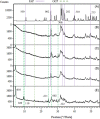Application of Octacalcium Phosphate with an Innovative Household-scale Defluoridator Prototype and Behavioral Determinants of its Adoption in Rural Communities of the East African Rift Valley
- PMID: 32162775
- PMCID: PMC7687156
- DOI: 10.1002/ieam.4262
Application of Octacalcium Phosphate with an Innovative Household-scale Defluoridator Prototype and Behavioral Determinants of its Adoption in Rural Communities of the East African Rift Valley
Abstract
Natural fluoride contamination of drinking water is a serious issue that affects several countries of the world. Its negative health impact is well documented in the East African Rift Valley, where water consumption with fluoride ( ) concentration greater than 1.5 mg/L can cause fluorosis to people. Within the framework of the European Union (EU) Horizon 2020 FLOWERED project, we first designed an effective defluoridation device based on innovative application of octacalcium phosphate (OCP) and then explored its acceptance within rural communities. The prototype (FLOWERED Defluoridator Device [FDD]) essentially is composed of a 20-L tank and a recirculating pump that guarantees the interaction between water and OCP. The device is powered by a car battery for a fixed pumping working time using a fixed amount of OCP for every defluoridation cycle. The results of tests performed in the rural areas of Tanzania show that a standardized use of the prototype can lower the dissolved from an initial concentration of 21 mg/L to below the World Health Organization (WHO) drinkable limit of 1.5 mg/L in 2 h without secondary negative effects on water quality. The approximate cost of this device is around US$220, whereas that of OCP is about $0.03/L of treated water. As with any device, acceptance requires a behavioral change on behalf of rural communities that needed to be investigated. To this end, we piloted a survey to explore how psychological and socioeconomic factors influence the consumption of fluoride-free water. Results show that the adoption of FDD and OCP is more appealing to members of the rural communities who are willing to pay more and have a high consumption of water. Moreover, we suggest that given the low level of knowledge about fluorosis diseases, the government should introduce educational programs to make rural communities aware of the negative health consequences. Integr Environ Assess Manag 2020;16:856-870. © 2020 The Authors. Integrated Environmental Assessment and Management published by Wiley Periodicals LLC on behalf of Society of Environmental Toxicology & Chemistry (SETAC).
Keywords: Defluoridation method; Fluoride contamination of groundwater; Fluorosis; Octacalcium Phosphate (OCP); RANAS behavioral model.
© 2020 The Authors. Integrated Environmental Assessment and Management published by Wiley Periodicals LLC on behalf of Society of Environmental Toxicology & Chemistry (SETAC).
Figures






Similar articles
-
A review on the potential sources and health implications of fluoride in groundwater of Sub-Saharan Africa.J Environ Sci Health A Tox Hazard Subst Environ Eng. 2020;55(9):1078-1093. doi: 10.1080/10934529.2020.1770516. Epub 2020 Jun 11. J Environ Sci Health A Tox Hazard Subst Environ Eng. 2020. PMID: 32525728 Review.
-
Fluoride exposure from groundwater as reflected by urinary fluoride and children's dental fluorosis in the Main Ethiopian Rift Valley.Sci Total Environ. 2014 Oct 15;496:188-197. doi: 10.1016/j.scitotenv.2014.07.048. Epub 2014 Jul 30. Sci Total Environ. 2014. PMID: 25084227
-
Groundwater quality and its health impact: An assessment of dental fluorosis in rural inhabitants of the Main Ethiopian Rift.Environ Int. 2012 Aug;43:37-47. doi: 10.1016/j.envint.2012.03.002. Epub 2012 Apr 6. Environ Int. 2012. PMID: 22484218
-
Defluoridation of water through the transformation of octacalcium phosphate into fluorapatite.Heliyon. 2019 Aug 14;5(8):e02288. doi: 10.1016/j.heliyon.2019.e02288. eCollection 2019 Aug. Heliyon. 2019. PMID: 31463396 Free PMC article.
-
Fluoride concentration in ground water and prevalence of dental fluorosis in Ethiopian Rift Valley: systematic review and meta-analysis.BMC Public Health. 2019 Oct 16;19(1):1298. doi: 10.1186/s12889-019-7646-8. BMC Public Health. 2019. PMID: 31619212 Free PMC article.
Cited by
-
Innovative Research Approaches to Cope with Water Security in Africa.Integr Environ Assess Manag. 2020 Nov;16(6):853-855. doi: 10.1002/ieam.4337. Epub 2020 Oct 6. Integr Environ Assess Manag. 2020. PMID: 32886398 Free PMC article.
-
Mineralogical-geochemical study of the anionic competition effect on the octacalcium phosphate reaction into fluorapatite.Heliyon. 2021 May 13;7(5):e06882. doi: 10.1016/j.heliyon.2021.e06882. eCollection 2021 May. Heliyon. 2021. PMID: 34136670 Free PMC article.
References
-
- Akuno MH, Nocella G, Milia EP, Gutierrez L. 2019. Factors influencing the relationship between fluoride in drinking water and dental fluorosis: A ten‐year systematic review and meta‐analysis. J Water Health 17(6):845–862. - PubMed
-
- Albertus J, Bregnhøj H, Kongpun M. 2000. Bone char quality and defluoridation capacity in contact precipitation. In: Proceedings of 3rd International Workshop on Fluorosis Prevention and Defluoridation of Water; 2000 Nov 20–24; Chaing Mai, Thailand. Dunedin (NZ): ISFR, EnDeCo & ICOH. p 61–72.
-
- Alkurdi SSA, Al‐Juboori RA, Bundschuh J, Hamawand I. 2019. Bone char as a green sorbent for removing health threatening fluoride from drinking water. Environ Int 127:704–719. - PubMed
-
- Amini M, Mueller KIM, Abbaspour KC, Rosenberg T, Afyuni M, Møller KN, Sarr M. 2008. Statistical modeling of global geogenic fluoride contamination in groundwaters. Environ Sci Technol 42:3662–3668. - PubMed
-
- Ayoob S, Gupta AK, Bhat VT. 2008. A conceptual overview on sustainable technologies for the defluoridation of drinking water. Crit Rev Environ Sci Technol 38:401–470.
MeSH terms
Substances
Grants and funding
- 690378/FLOWERED project (Coordinator G. Ghiglieri), Horizon 2020 European funded project
- DOT1304527/Italian Ministry of Education, Universities and Research. FSE-FESR Research and innovation (PON RI) 2014-2020. Innovative Doctoral Programmes with Industrial Orientation
- Grant Agreement - N. 690378/FLOWERED project (Coordinator G. Ghiglieri), Horizon 2020 European funded project
LinkOut - more resources
Full Text Sources
Medical
Research Materials

